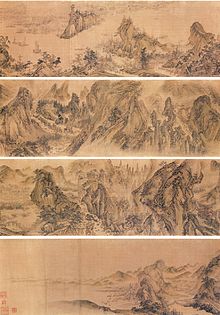Yi In-mun
 From Wikipedia - Reading time: 5 min
From Wikipedia - Reading time: 5 min
This article includes a list of references, related reading, or external links, but its sources remain unclear because it lacks inline citations. (March 2024) |
| Yi In-mun | |
| Hangul | 이인문 |
|---|---|
| Hanja | 李寅文 |
| Revised Romanization | I In-mun |
| McCune–Reischauer | Yi Inmun |
| Art name | |
| Hangul | 유춘 or 고송류수관도인 |
| Hanja | 有春 or 古松流水館道人 |
| Revised Romanization | Yuchun or Gosongnyusugwandoin |
| McCune–Reischauer | Yuch'un or Kosongnyusugwandoin |
| Courtesy name | |
| Hangul | 문욱 |
| Hanja | 文郁 |
| Revised Romanization | Munuk |
| McCune–Reischauer | Munuk |

Yi Inmun (Korean: 이인문; Hanja: 李寅文; 1745–1821), also known as Yuchun, was a court painter of the late Joseon Dynasty, primarily of landscapes. He also held a military position in the court. Perhaps his best-known work is a silk scroll entitled Gangsan mujindo (강산무진도; 江山無盡圖; lit. Streams and Mountains Without End), which is displayed in the National Museum of Korea in Seoul.
In 1968, the American composer Alan Hovhaness (who had visited South Korea in 1963) composed a chamber symphony inspired by Yi's painting, entitled Mountains and Rivers Without End.
See also
[edit]References
[edit]External links
[edit]- http://www.artnet.com/library/09/0928/T092841.asp accessed August 13, 2005
- http://www.metmuseum.org/toah/hd/mowa/hd_mowa.htm accessed August 13, 2005
- http://www.towooart.com/oldart/old_korea/leeinmun/leeinmun.htm
- Arts of Korea, an exhibition catalog from The Metropolitan Museum of Art Libraries (fully available online as PDF), which contains material on Yi In-mun
Wikimedia Commons has media related to Yi In-mun.
Licensed under CC BY-SA 3.0 | Source: https://en.wikipedia.org/wiki/Yi_In-mun8 views | Status: cached on March 24 2025 11:50:30↧ Download as ZWI file
 KSF
KSF